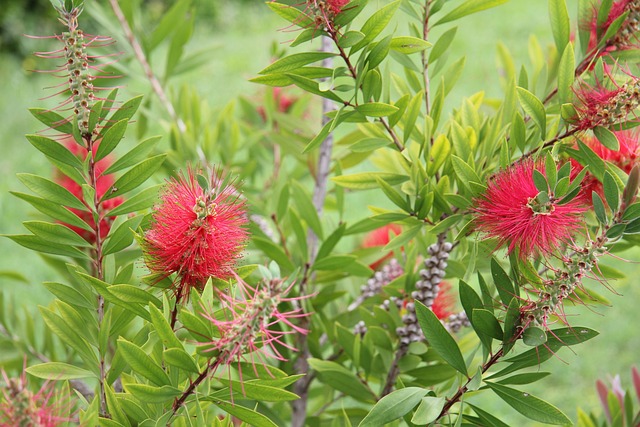Top 10 Desert Plants: Names, Pictures, and Care Tips for Arid Gardens
Desert plants thrive in hot, dry conditions where they need little precipitation to survive. The characteristics of the desert biome include rocky or sandy soil, intense heat, and little precipitation. Prosperous desert plants have large root systems or store moisture in their succulent leaves in order to withstand these severe circumstances.
Typically, plants that flourish in desert conditions should have the following characteristics:
- They should like full sun and do not need shade.
- They must be drought-tolerant, including plants, shrubs, and trees that can live with little water.
- They should thrive in sandy, arid soil conditions.
- They include cactus, succulents, shrubs, and trees that can withstand hot days and chilly nights.
This article gives a list of common desert plants, together with descriptions, photos, and scientific names, to help you choose the best option for your yard.
1. Bottlebrush (Callistemon)

Bottlebrush plants are tiny shrubs that require little watering and grow well in full sun. They are native to Australia and may thrive in a variety of environments, including deserts. Usually, these plants have bright red bottlebrush-shaped flowers that look stunning against their light green, needle-like leaves.
2. Yellow Bells (Tecoma Stans)

A flowering desert shrub with a reputation for withstanding heat and dryness is called Yellow Bells. It yields funnel-shaped, vivid golden-yellow flowers, as the name implies. It changes from having emerald green leaves to a bright yellow profusion of blossoms. This shrub is a great option for landscaping in the desert, especially if you require an ornamental plant that will bloom in full light.
3. Texas Sage (Leucophyllum Frutescens)

Compact shrubs like Texas sage are often found in desert environments, especially in Southern Arizona. It grows best in full sun, is very drought-tolerant, hardy, and little maintenance. In addition to its adaptability, this plant yields vivid purple flowers that brighten any scene.
4. Pencil Plant (Euphorbia Tirucalli)

These succulents are a common option for contemporary landscapers and are frequently utilised in drought-tolerant landscaping. When the plant is stressed by conditions like little water, low temperatures, or poor soil nutrients, its green, pencil-like stems turn bright coral.
In order to encourage this succulent and other varieties to show off their vivid and eye-catching colours, gardeners frequently purposefully deprive them of nutrients or water.
5. Mojave Aster (Xylorhiza Tortifolia)

One of the most beautiful flowering desert plants is the Mojave Aster. This resilient plant, which is native to the Mojave Desert, can withstand heat and drought.
Its petals radiate from a vivid yellow centre in a beautiful lavender and white mix. These beautiful plants can also be found in the Great Basin and Sonoran deserts.
6. Mexican Feather Grass (Nassella Tenuissima)

This desert plant is indigenous to Mexico, Argentina, and the Southwest US, where temperatures are high. It needs dry soil, grows well in full sun, and can withstand severe droughts.
Mexican Feather Grass is a fine-textured, wispy grass that adds beauty to any desert setting. It looks particularly beautiful when planted in borders or attractive containers.
7. Lady Banks Rose (Rosa Banksiae)

The distinctive dark green, glossy leaves of the Lady Banks Rose grow in a manner like to a vine. It’s a favourite for arrangement and trimming because of its long, flexible canes that have few to no thorns. This is a very strong rose in a desert setting, despite the absence of fragrance in its pale yellow petals.
8. Jumping Cholla (Cylindropuntia Fulgida)

Tree-like plants called jumping chollas grow in the Sonoran Desert of Arizona and Southern California. Their distinctive feature is a broad trunk with branches sprouting from the top, all of which are armed with vicious spines.
The plant gets its unique look from this. Jumping Chollas can reach an astonishing height of about 13 feet and produce flowers that are pink and white with lavender patterns.
9. Golden Barrel Cactus (Echinocactus Grusonii)

The Golden Barrel Cactus has the highest heat tolerance of any desert plant. This cylindrical cactus has little yellow flowers on top and is covered in many sharp yellow or white spines.
These cacti are less common in deserts than they were a few years ago because of habitat degradation. Nevertheless, they can last up to 30 years and are great complements to any garden!
10. Desert Marigold (Baileya)

These resilient perennials with flowers grow well in the deserts of Utah, Arizona, California, and Mexico. Like other marigold types, this one improves up otherwise gloomy surroundings with a flash of brilliant yellow.
It blooms from spring through the hottest months of the year with huge, disc-shaped flowers. These plants not only withstand high temperatures, but they also need little water to thrive in direct sunlight.
Conclusion
This article features a carefully curated list of the most common and robust desert plants, which thrive in arid, harsh circumstances. We’ve narrowed down our top ten selections for you to consider.
Desert plants are known for their strength, drought resistance, and ability to inject brilliant colours into otherwise harsh landscapes—though these characteristics can vary greatly between species.
Contrary to popular assumption, desert landscaping includes more than simply cactus and succulents. The range of plants that thrive in arid environments is huge and often daunting to consider.
Whether you want to add colour to your yard or just learn more about desert flora, we hope this information was helpful.



Well done 🥰